brianc053
Hero Member
- Jan 27, 2015
- 985
- 3,412
- 🏆 Honorable Mentions:
- 3
- Detector(s) used
- Minelab Equinox 800
XP Deus 2
- Primary Interest:
- Metal Detecting
I often have to travel for work, and when I do I try to squeeze in some prospecting if at all possible.
This past week my job required me to fly out to California for a few meetings, and since I had a few weeks advance notice I decided to plan a side trip up to Placer County California. With a name like that, the prospecting had to be good! I had never prospected Northern CA before, so I was excited to give it a try.
Through a local GPAA chapter I arranged to connect with a local prospector named "Sourdough Joe" and visit a public prospecting area near Colfax, CA. Colfax is about halfway between Sacramento and Lake Tahoe.
Sourdough Joe (I can't just call him Joe) and I arranged to meet on Friday morning at 7AM - just as the sun was rising - at Bear River, which has a county campground of the same name. There's a day-use parking lot along the River that is free, and the location allows all non-moterized prospecting tools.
When I travel and I know I'm going to prospect I take along a checked luggage bag that carries all the essentials - sluice, buckets, small shovel, pans, hip waders and various other gear. But on this occasion I didn't need most of that; Sourdough Joe was an incredibly generous guy and he offered an incredible partnership: he and I would dig together, using his wheelbarrow classifier method, and we'd split the gold 50/50! What a deal! Of course I said yes.
About this "wheelbarrow classifier": picture a wheelbarrow with a rectangular screen on it made of the same raised metal that we use in our sluices; the screen sat down about 2 inches into the wheelbarrow. We would fill the wheelbarrow with water, which would cover the screen, and then shovel right onto the screen. One guy would shovel and the other would work the dirt on the screen, throwing aside the larger rocks. After about 20-30 shovelfuls the finer gravel would fill the wheelbarrow.
The dig location was about 50 yards from the river, so we'd have to transfer the material from the wheelbarrow to buckets and carry those down to the river and the sluice. So, you can imagine this was a lot of physical labor.
But I'm way ahead of myself.
When we got there Joe trusted me to take some test pans from various locations. Now, to paint you a mental picture I have to try to describe the River and the "bar" - the large swath of gravel that accumulates at the bend in the River. This bar was huge. I'm talking 100 yards wide and maybe a quarter of a mile long. [if you google map "Bear River Campground Colfax" and you look along the Bear River while in satellite view mode you will see the bar I'm talking about].
So with all that gravel, I had to trust Joe to pick a good location. But even he doesn't trust his "intuition", so he relies on test pans. The gravel bar has been heavily prospected, and the evidence was everywhere: it looked like a cratered moon. And I learned from Joe (Ok, typing "sourdough" over and over is annoying) that it's totally ok to pick someone else's crater and start expanding it. So I tested a few by digging some material from the left side and the right side of the crater; the idea was that we would expand the crater in whatever direction showed the most color.
This was the moment where I was glad I've been practicing panning material at home and along the East Coast over the past few years. I knew Joe was watching me and evaluating whether this East Coast guy knew anything about gold prospecting. And I don't think I disappointed him; I pulled two shovelfuls of material out of each end of the crater and classified it using a 1/4" mesh, and then I took the two pans down to the River. In the righthand pan I found about 12 colors in just those two shovelfuls of dirt! [The lefthand pan had only 3 or 4 colors - we dug to the right]. Here's a picture of that first pan - see the colors at the top?
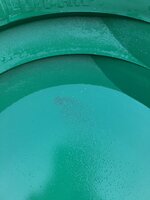
Before we started moving lots of material, and for comparison purposes Joe had me test pan one other area, which was over near some bushes. I learned that it's NOT OK to dig up any bushes on the gravel bar, but if there's some small grass or weeds growing it was OK to dig those up - and usually those indicated "virgin" material (or at least stuff that wasn't disturbed recently). In this other location I panned a nice flake and about 10 colors, but we decided that there wasn't enough space around the bush, so we went back to the original location.
A quick note about the "material": I've said "dirt", but this isn't dirt. The gravel bar is made up of round river stones varying in size from marbles up to baseball and even basketball sized. Mixed in with those stones is sand - black sand, blond sand, a little clay - and the gold. This River is flooded annually, when there are snow melts and also if it rains hard (like it did in late Winter in California). The gold is "flood gold", replenished and moved around every time the water rises up.
And it's hard material to move. Every shovelful has a big rock in it, and they're heavy. Shoveling through them is tough. Anyway, back to Joe's wheelbarrow.
Throughout the day we moved 6 wheelbarrows worth of material. Joe estimated this to be about 1.5 yards of classified material. We pulled 5 wheelbarrows full from the primary digging location, and for fun we pulled our last wheelbarrow of material from the area near the bush. We did a cleanup before this last wheelbarrow, and then ran the last one's material separately. I believe it (the bush location) had flakier gold, but it was tough to tell. You can see the results in the pictures below; all of the gold was flour gold with a few flakes mixed in, which was to be expected since flood gold is typically fine.
I would come back to this location in a heartbeat. It has everything: gold (obviously), ease of access, legal public parking with no fee, good camaraderie with others on location, and cell phone service (I had to take a 60 minute break at lunchtime to hold a work conference call).
- Brian
The sunrise as I drove to Bear River:
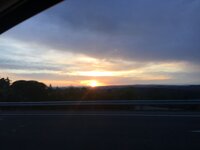
The Gold - My 50% of the final take:
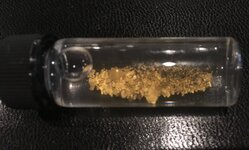
The area (notice Joe's LeTrap sluice in the middle - that's what we used today):
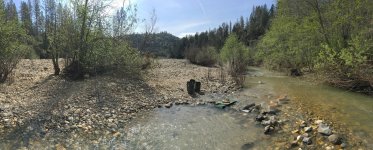
Gold in the sluice (at the half-way mark, i.e. 3 wheelbarrows into the day):
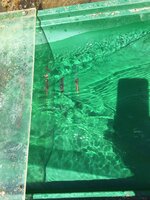
A Selfie on the Bar:
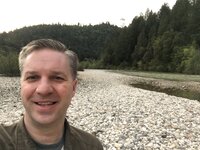
This past week my job required me to fly out to California for a few meetings, and since I had a few weeks advance notice I decided to plan a side trip up to Placer County California. With a name like that, the prospecting had to be good! I had never prospected Northern CA before, so I was excited to give it a try.
Through a local GPAA chapter I arranged to connect with a local prospector named "Sourdough Joe" and visit a public prospecting area near Colfax, CA. Colfax is about halfway between Sacramento and Lake Tahoe.
Sourdough Joe (I can't just call him Joe) and I arranged to meet on Friday morning at 7AM - just as the sun was rising - at Bear River, which has a county campground of the same name. There's a day-use parking lot along the River that is free, and the location allows all non-moterized prospecting tools.
When I travel and I know I'm going to prospect I take along a checked luggage bag that carries all the essentials - sluice, buckets, small shovel, pans, hip waders and various other gear. But on this occasion I didn't need most of that; Sourdough Joe was an incredibly generous guy and he offered an incredible partnership: he and I would dig together, using his wheelbarrow classifier method, and we'd split the gold 50/50! What a deal! Of course I said yes.
About this "wheelbarrow classifier": picture a wheelbarrow with a rectangular screen on it made of the same raised metal that we use in our sluices; the screen sat down about 2 inches into the wheelbarrow. We would fill the wheelbarrow with water, which would cover the screen, and then shovel right onto the screen. One guy would shovel and the other would work the dirt on the screen, throwing aside the larger rocks. After about 20-30 shovelfuls the finer gravel would fill the wheelbarrow.
The dig location was about 50 yards from the river, so we'd have to transfer the material from the wheelbarrow to buckets and carry those down to the river and the sluice. So, you can imagine this was a lot of physical labor.
But I'm way ahead of myself.
When we got there Joe trusted me to take some test pans from various locations. Now, to paint you a mental picture I have to try to describe the River and the "bar" - the large swath of gravel that accumulates at the bend in the River. This bar was huge. I'm talking 100 yards wide and maybe a quarter of a mile long. [if you google map "Bear River Campground Colfax" and you look along the Bear River while in satellite view mode you will see the bar I'm talking about].
So with all that gravel, I had to trust Joe to pick a good location. But even he doesn't trust his "intuition", so he relies on test pans. The gravel bar has been heavily prospected, and the evidence was everywhere: it looked like a cratered moon. And I learned from Joe (Ok, typing "sourdough" over and over is annoying) that it's totally ok to pick someone else's crater and start expanding it. So I tested a few by digging some material from the left side and the right side of the crater; the idea was that we would expand the crater in whatever direction showed the most color.
This was the moment where I was glad I've been practicing panning material at home and along the East Coast over the past few years. I knew Joe was watching me and evaluating whether this East Coast guy knew anything about gold prospecting. And I don't think I disappointed him; I pulled two shovelfuls of material out of each end of the crater and classified it using a 1/4" mesh, and then I took the two pans down to the River. In the righthand pan I found about 12 colors in just those two shovelfuls of dirt! [The lefthand pan had only 3 or 4 colors - we dug to the right]. Here's a picture of that first pan - see the colors at the top?

Before we started moving lots of material, and for comparison purposes Joe had me test pan one other area, which was over near some bushes. I learned that it's NOT OK to dig up any bushes on the gravel bar, but if there's some small grass or weeds growing it was OK to dig those up - and usually those indicated "virgin" material (or at least stuff that wasn't disturbed recently). In this other location I panned a nice flake and about 10 colors, but we decided that there wasn't enough space around the bush, so we went back to the original location.
A quick note about the "material": I've said "dirt", but this isn't dirt. The gravel bar is made up of round river stones varying in size from marbles up to baseball and even basketball sized. Mixed in with those stones is sand - black sand, blond sand, a little clay - and the gold. This River is flooded annually, when there are snow melts and also if it rains hard (like it did in late Winter in California). The gold is "flood gold", replenished and moved around every time the water rises up.
And it's hard material to move. Every shovelful has a big rock in it, and they're heavy. Shoveling through them is tough. Anyway, back to Joe's wheelbarrow.
Throughout the day we moved 6 wheelbarrows worth of material. Joe estimated this to be about 1.5 yards of classified material. We pulled 5 wheelbarrows full from the primary digging location, and for fun we pulled our last wheelbarrow of material from the area near the bush. We did a cleanup before this last wheelbarrow, and then ran the last one's material separately. I believe it (the bush location) had flakier gold, but it was tough to tell. You can see the results in the pictures below; all of the gold was flour gold with a few flakes mixed in, which was to be expected since flood gold is typically fine.
I would come back to this location in a heartbeat. It has everything: gold (obviously), ease of access, legal public parking with no fee, good camaraderie with others on location, and cell phone service (I had to take a 60 minute break at lunchtime to hold a work conference call).
- Brian
The sunrise as I drove to Bear River:

The Gold - My 50% of the final take:

The area (notice Joe's LeTrap sluice in the middle - that's what we used today):

Gold in the sluice (at the half-way mark, i.e. 3 wheelbarrows into the day):

A Selfie on the Bar:

Upvote
0





